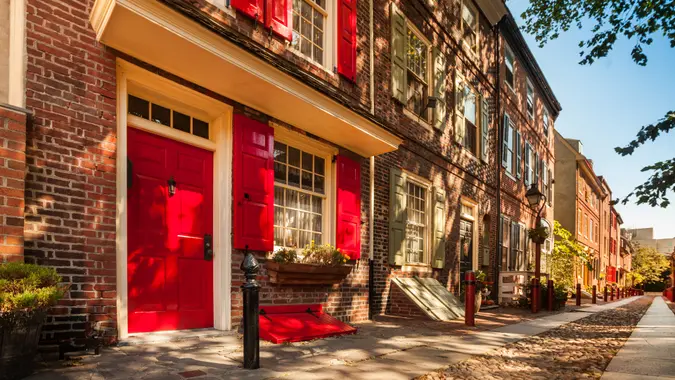Trump Won the Election: 7 Changes That Could Be Coming to the Cost of Living in America’s Largest Cities

Commitment to Our Readers
GOBankingRates' editorial team is committed to bringing you unbiased reviews and information. We use data-driven methodologies to evaluate financial products and services - our reviews and ratings are not influenced by advertisers. You can read more about our editorial guidelines and our products and services review methodology.

20 Years
Helping You Live Richer

Reviewed
by Experts

Trusted by
Millions of Readers
Incoming President Donald Trump made plenty of promises on the campaign trail that could affect affordability in major cities — both for better and for worse.
As you peer into the crystal ball of how a second Trump presidency could impact urban life, keep the following possibilities in mind.
Continued SALT Deduction Cap for High-End Homeowners
The Tax Cuts and Jobs Act of 2017 doubled the standard deduction and reshuffled income tax brackets to allow most taxpayers to pay lower net rates. It also capped state and local tax (SALT) deductions at $10,000 per year.
That cap mostly impacts high-income Americans who own expensive homes and itemize their deductions, including property taxes and mortgage interest. The higher standard deduction means that most low- and middle-income Americans no longer bother itemizing. In fact, the Tax Policy Center reported that nearly a third of taxpayers itemized deductions in 2017, before the TCJA went into effect, and by 2020, that percentage dropped to 9%.
“Trump has proposed extending the provisions of the Tax Cuts and Jobs Act that expire at the end of 2025,” said Mark Luscombe, principal analyst for Wolters Kluwer’s North American tax and accounting division. “Extending all of the provisions of TCJA would also extend the state and local tax deduction limit of $10,000.
“That said, Trump has floated the idea of letting that limit expire. Time will tell.”
Decentralizing Washington Could Boost Local Affordability
Jaye Hohman, founder of mortgage lender Hohman Finance, said Washington, D.C. could see a dip in housing demand if Trump does decentralize the federal government as pledged.
“The U.S. Bureau of Economic Analysis reports there were 2.314 million civilian federal employees in 2023. In addition to decreasing the size of government, President-elect Trump has suggested decentralizing the departments, moving the bureaucracy away from D.C.,” he said. “Locally, this would put downward pressure on home prices and boost affordability.”
And with Zillow reporting a median home price of $602,548, Washington could definitely use more affordable housing.
Housing Construction Incentives Could Help Affordability
Austin Glanzer, real estate investor and founder of 717HomeBuyers, said Trump’s focus on deregulation could increase affordable housing options in major cities.
“By cutting red tape in the housing and construction industries, there’s potential for faster development and more streamlined processes for building homes,” he explained. “This could boost supply and reduce the housing shortage for renters and buyers alike, helping affordability.”
Mass Deportations Impact on Major Cities
Immigration and mass deportations have proven recurring themes in Trump’s reelection campaign.
The Center for Immigration Studies estimated that there were around 14 million immigrants without legal status living in the U.S. in February of 2024. If Trump succeeds in deporting even a fraction of them, it could drain millions of residents from America’s cities.
That would reduce demand for housing, putting downward pressure on rents and property values. But Albert Lord, founder of multifamily investing group Lexerd Capital Management, noted that it also reduces the workforce for new construction projects.
“In sectors that rely heavily on immigrant labor, such as construction, hospitality and real estate maintenance, tighter immigration policies may reduce the labor supply,” he said. “A labor shortage could drive up wages in these industries, resulting in increased costs for services, housing construction and other essentials, raising the overall cost of living in cities.”
Higher Material Costs for Construction and Home Renovations
Construction materials skyrocketed in price during and after the COVID-19 pandemic, averaging 19% increases from 2020 to 2024, according to insurance company Morris & Garritano. And they’re likely to rise further if Trump enacts import tariffs.
“Tariffs are almost certain,” said Jay Jung, founder of corporate finance advisory Embarc Advisors. “The question is how high.”
Trump has proposed a 60% tariff on all imports from China, and 10%-20% tariffs on imports from all other countries. That could make it even more expensive to build new homes or renovate older ones.
Broader Inflation
Home construction materials aren’t the only products that would become more expensive under new tariffs.
Lord added that businesses don’t just eat the cost of tariffs — they pass them along to consumers. “Tariffs on imported goods typically lead to higher prices for U.S. consumers, particularly affecting urban residents who already face higher living costs.”
Economic Stimulus for Major Cities
Cameron Love, founder of real estate company StrykCam, said Trump likes to press the accelerator for economic stimulus. “Trump has always pushed for policies that drive economic growth, and this could lead to job creation in urban areas. Increased employment opportunities can improve the standard of living and potentially reduce income inequality in larger cities.”
Indeed, protectionist policies like tariffs could boost domestic manufacturing, according to Tyler Vinsand of 757 Property Solutions. “When more goods are produced locally, it reduces the reliance on foreign imports, which can stabilize costs. Trump’s trade approach could help protect domestic jobs and reduce costs for certain everyday goods, which would be a benefit for city residents, as well as the broader economy.”
Can Trump truly grow the domestic economy without fanning the flames of inflation? It remains to be seen, as Trump’s dramatic policy changes could impact urban life in complex and unpredictable ways. His voters appear to want a shake-up of the status quo — and they’ll likely get it under a second Trump presidency.
Editor’s note on political coverage: GOBankingRates is nonpartisan and strives to cover all aspects of the economy objectively and present balanced reports on politically focused finance stories. You can find more coverage of this topic on GOBankingRates.com.
 Written by
Written by  Edited by
Edited by 

























